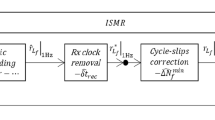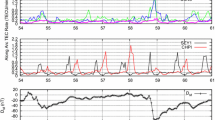Abstract
We propose an algorithm for estimating the ionospheric scintillation phase on global navigation satellite systems (GNSS) receivers for scintillation monitoring. The algorithm comprises linear time-invariant filtering of available observables or easily derived in traditional or Kalman filter-based carrier tracking loop structures, exploiting their complementary frequency content to provide real-time scintillation phase estimates for monitoring purposes. This algorithm is developed for receivers with traditional and Kalman frequency locked loops, but can be adapted to receivers with traditional and Kalman phase locked loops. The performance of the algorithm is evaluated via simulations with synthetic severe scintillation data, showing its capability to provide the scintillation phase estimates. In addition, we evaluated the algorithm with real data presenting equatorial scintillation collected by a professional GNSS receiver, where the scintillation phase standard deviation computed from the estimates provided by the real-time algorithm is compared to the standard deviation derived by post-processing, showing good agreement.















Similar content being viewed by others
Data availability
The data that support the findings of this study are available from the corresponding author upon request.
References
Banville S, Langley RB (2013) Mitigating the impact of ionospheric cycle slips in GNSS observations. J Geodesy 87(2):179–193. https://doi.org/10.1007/s00190-012-0604-1
Bar-Shalom Y, Li XR, Kirubarajan T (2001) Estimation with applications to tracking and navigation. John Wiley and Sons, USA. https://doi.org/10.1002/0471221279
Brown RG, Hwang PC (1996) Introduction to random signals and applied Kalman filtering. John Wiley & Sons, New York. https://doi.org/10.1002/rnc.4590020307
Cristodaro C, Dovis F, Linty N, Romero R (2018) Design of a configurable monitoring station for scintillations by means of a GNSS software radio receiver. IEEE Geosci Remote Sens Lett 15(3):325–329. https://doi.org/10.1109/LGRS.2017.2778938
Curran JT, Bavaro M, Morrison A, Fortuny J (2015) Event identication & recording for scintillation monitoring stations. In: Proceedings of the 2015 international technical meeting of The Institute of Navigation, pp 114–122
Dierendonck JV, Klobuchar AJ, Hua Q (1993) Ionospheric scintillation monitoring using commercial single frequency C/A code receivers. In: Proceedings of ION GPS 1993, Institute of Navigation, Salt Lake City, Utah, USA, pp 1333–1342
Fohlmeister F, Antreich F, Nossek JA (2018a) Dual Kalman filtering based GNSS phase tracking for scintillation mitigation. In: IEEE/ION position, location and navigation symposium (PLANS). Monterey, CA, pp 1151–1158. https://doi.org/10.1109/PLANS.2018.8373499
Fohlmeister F, Antreich F, Nossek JA (2018b) Dual Kalman Filtering based Analysis of GNSS Data from Low Latitudes. In: 52nd asilomar conference on signals, systems, and computers. Pacific Grove, CA, pp 532–536. https://doi.org/10.1109/ACSSC.2018.8645349
Forte B (2007) On the relationship between the geometrical control of scintillation indices and the data detrending problems observed at high latitudes. Ann Geophys 50(6):699–706. https://doi.org/10.4401/ag-3051
Fremouw EJ, Leadabrand RL, Livingston RC, Cousins MD, Rino CL, Fair BC, Long RA (1978) Early results from the DNA Wide band satellite experiment - complex-signal scintillation. Radio Sci 13(1):167–187. https://doi.org/10.1029/RS013i001p00167
GNSS J (2018) JAVAD Delta 3. Rev 1.5. http://www.javad.com/
Humphreys TE, Psiaki ML, Kintner PM (2010) Modeling the effects of ionospheric scintillation on GPS carrier phase tracking. IEEE Trans Aerosp Electron Syst 46(4):1624–1637. https://doi.org/10.1029/2000RS002604
Humphreys TE, Psiaki ML, Kintner PM (2005) GPS carrier tracking loop performance in the presence of ionospheric scintillations. In: Proceedings of ION GNSS 2005, Institute of Navigation, Long Beach, California, USA, pp 156–167
Lee J, Morton J, Moon H, Seo J (2017) Monitoring and mitigation of ionospheric anomalies for GNSS-based safety critical systems: a review of up-to-date signal processing techniques. IEEE Signal Process Mag 34(5):96–110. https://doi.org/10.1109/MSP.2017.2716406
Legrand F, Macabiau C, Issler J-L, Lestarquit L, Mehlen C (2000) Improvement of pseudorange measurements accuracy by using fast adaptive bandwidth lock loops. In: Proceedings ION GPS 2000, Institute of Navigation, Salt Lake City, Utah, USA, pp 2346–2356
Linty N, Minetto A, Dovis F, Spogli L (2018) Effects of phase scintillation on the GNSS positioning error during the September 2017 storm at Svalbard. SpaceWeather 16(9):1317–1329. https://doi.org/10.1029/2018SW001940
Mayer C, Belabbas B, Jakowski N, Meurer M, Dunkel W (2009) Ionosphere threat space model assessment for GBAS. In: Proceedings of ION GNSS 2009, Institute of Navigation, Savannah, Georgia, USA, pp 1091–1099
Moraes AO, Rodrigues FS, Perrella WJ, de Paula ER (2012) Analysis of the characteristics of low-latitude GPS amplitude scintillation measured during solar maximum conditions and implications for receiver performance. Surv Geophys 33(5):1107–1131. https://doi.org/10.1007/s10712-011-9161-z
Niu F, Morton Y, Taylor S, Pelgrum W, Dierendonck AJV (2012) Performances of GPS signal observables detrending methods for ionosphere scintillation studies. In: Proceedings ION GNSS 2012, Institute of Navigation, Nashville, Tennessee, USA, pp 3435–3443
O'Hanlon B, Psiaki M, Powell S, Bhatti J, Humphreys TE, Crowley G, Bust G (2011) Cases: a smart, compact GPS software receiver for space weather monitoring. In: Proceedings of ION GNSS 2011, Institute of Navigation, Portland, Oregon, USA, pp 2745–2753
Teunissen PJG, Montenbruck O (eds) (2017) Springer Handbook of global navigation satellite systems. Springer International. https://doi.org/10.1007/978-3-319-42928-1_4
Vilá-Valls J, Closas P, Navarro M, Fernandez-Prades C (2017a) Are PLLs dead? A tutorial on Kalman filter-based techniques for digital carrier synchronization. IEEE Aerosp Electron Syst Mag 32(7):28–45. https://doi.org/10.1109/MAES.2017.150260
Vilá-Valls J, Linty N, Closas P, Dovis F, Curran JT (2020) Survey on signal processing for GNSS under ionospheric scintillation: detection, monitoring, and mitigation. Navigation 67(3):511–536. https://doi.org/10.1002/navi.379
Vilà-Valls J, Closas P, Curran JT (2017b) Multi-frequency GNSS robust carrier tracking for ionospheric scintillation mitigation. J Space Weather Space Clim 7:A26. https://doi.org/10.1051/swsc/2017020
Vilá-Valls J, Fernandez-Prades C, Curran JT, Closas P (2017b) Challenges of using low-cost GNSS receivers for ionospheric scintillation monitoring. In: Proceedings of the 6th ESA international colloquium on scientific and fundamental aspects of GNSS/Galileo.
Xu R, Liu Z, Chen W (2015b) Improved FLL-assisted PLL with in-phase pre-filtering to mitigate amplitude scintillation effects. GPS Solut 19:263–276. https://doi.org/10.1007/s10291-014-0385-5
Xu D, Morton Y, Akos D, Walter T (2015a) GPS multi-frequency carrier phase characterization during strong equatorial ionospheric scintillation. In: Proceedings of ION GNSS 2015a, Institute of Navigation, Tampa, Florida, USA, pp 3787–3796
Xu D, Morton Y (2018) A semi-open loop GNSS carrier tracking algorithm for monitoring strong equatorial scintillation. IEEE Trans Aerosp Electron Syst 54(2):722–738 https://doi.org/10.1109/TAES.2017.2764778
Zhang L, Morton YT (2009) Tracking GPS signals under ionospheric scintillation conditions. In: Proceedings of ION GNSS 2009, Institute of Navigation, Savannah, Georgia, USA, pp 227–234
Zhang L, Morton Y, van Graas F, Beach T (2010) Characterization of GNSS signal parameters under ionosphere scintillation conditions using software-based tracking algorithms. In: IEEE/ION position, location and navigation symposium. Indian Wells, CA, pp 264–275. https://doi.org/10.1109/PLANS.2010.5507209.
Acknowledgements
This work was partially supported by the Brazilian National Council for Scientific and Technological Development (CNPq) under Grant 309248/2018-3 PQ-2, 312394/2021-7 PQ-2, 409865/2018-4, 307255/2018-2, 465648/2014-2, and 205906/2018-4, as well as by the Coordination for the Improvement of Higher Education Personnel (CAPES) under the Programa de Apoio ao Ensino e a Pesquisa Científica e Tecnológica—Pró-Defesa IV and under Grant nº 88887.137186/2017-00. Furthermore, this work was also partially supported by FAPESP (Fundação de Amparo à Pesquisa do Estado de São Paulo) under Grant 2017/50115-0.
Author information
Authors and Affiliations
Corresponding author
Additional information
Publisher's Note
Springer Nature remains neutral with regard to jurisdictional claims in published maps and institutional affiliations.
Rights and permissions
Springer Nature or its licensor (e.g. a society or other partner) holds exclusive rights to this article under a publishing agreement with the author(s) or other rightsholder(s); author self-archiving of the accepted manuscript version of this article is solely governed by the terms of such publishing agreement and applicable law.
About this article
Cite this article
Lopes, R.A.M., Antreich, F., Fohlmeister, F. et al. Linear time-invariant filtering for real-time monitoring of ionospheric scintillation in GNSS receivers. GPS Solut 27, 131 (2023). https://doi.org/10.1007/s10291-023-01470-0
Received:
Accepted:
Published:
DOI: https://doi.org/10.1007/s10291-023-01470-0




